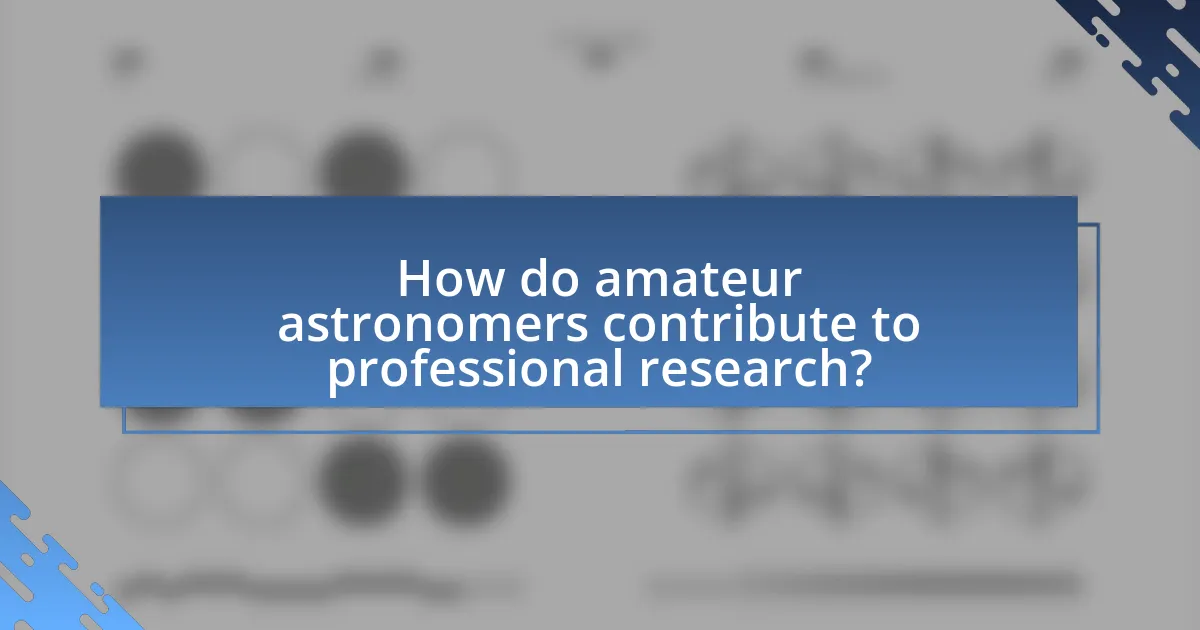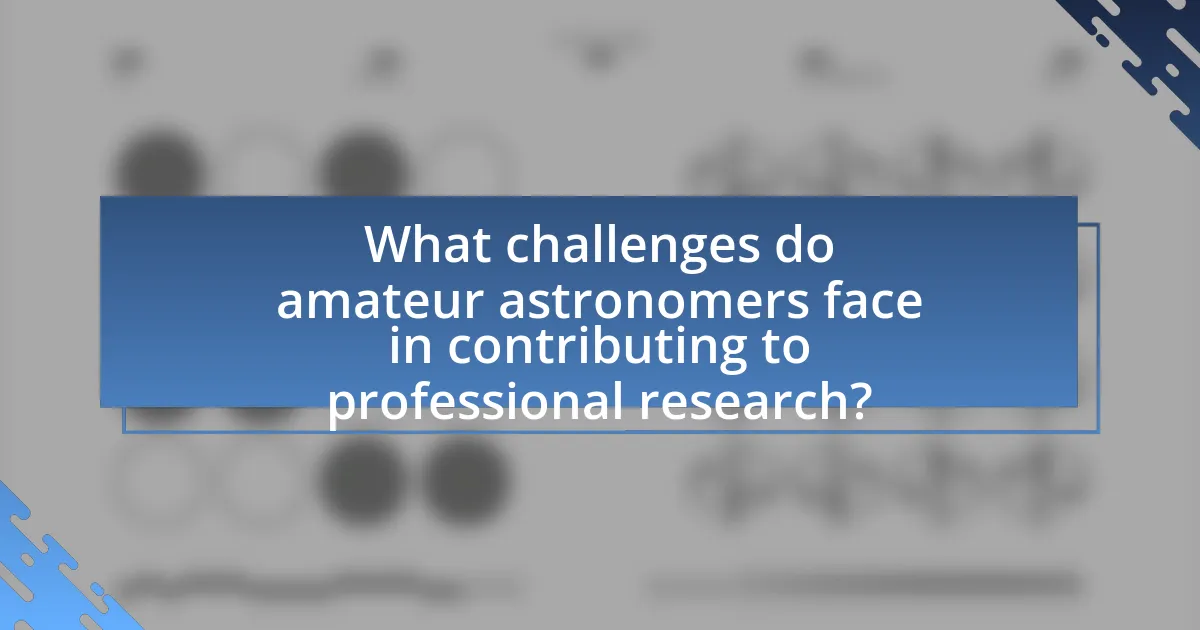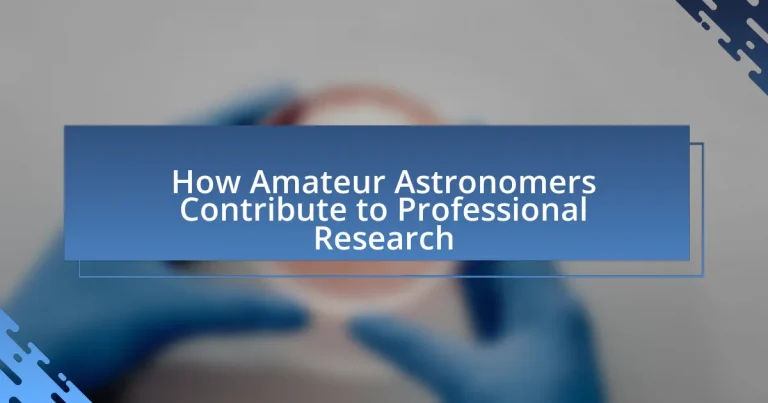Amateur astronomers play a significant role in professional research by providing valuable observational data that enhances scientific studies. They engage in systematic monitoring of celestial events, contributing to discoveries such as variable stars, supernovae, and asteroids. Collaborations with professional researchers and participation in citizen science projects, like the American Association of Variable Star Observers, exemplify the synergy between amateur and professional astronomy. This article explores the various contributions of amateur astronomers, the tools and technologies they utilize, the challenges they face, and the impact of their involvement on scientific discoveries.

How do amateur astronomers contribute to professional research?
Amateur astronomers contribute to professional research by providing valuable observational data that can complement and enhance scientific studies. They often engage in systematic monitoring of celestial events, such as variable stars, supernovae, and asteroids, which can lead to significant discoveries. For instance, the American Association of Variable Star Observers (AAVSO) has documented thousands of observations from amateurs that have been used in professional publications, demonstrating the impact of their contributions on the scientific community. Additionally, amateur astronomers frequently collaborate with professional researchers, sharing their findings and participating in citizen science projects, which further bridges the gap between amateur and professional astronomy.
What roles do amateur astronomers play in the field of astronomy?
Amateur astronomers play crucial roles in the field of astronomy by contributing to data collection, discovery, and public engagement. They often participate in observational campaigns, such as monitoring variable stars, tracking asteroids, and documenting celestial events, which can lead to significant discoveries. For instance, the discovery of the asteroid 1998 KY26 was made by an amateur astronomer, showcasing their potential to contribute to professional research. Additionally, amateur astronomers frequently collaborate with professional astronomers, providing valuable data that can enhance scientific understanding and support ongoing research projects. Their involvement in citizen science initiatives, such as the Galaxy Zoo project, further exemplifies how they assist in classifying astronomical data, thereby aiding professional astronomers in their work.
How do amateur astronomers assist in data collection?
Amateur astronomers assist in data collection by conducting observations and recording astronomical events, which can be valuable for professional research. They often utilize telescopes and imaging equipment to gather data on celestial phenomena such as variable stars, supernovae, and exoplanets. For instance, the American Association of Variable Star Observers (AAVSO) has documented that amateur astronomers contribute thousands of observations each year, which help in monitoring the brightness changes of stars. This collaborative effort enhances the overall dataset available for scientific analysis, allowing professionals to validate findings and expand their research scope.
What types of observations do amateur astronomers typically make?
Amateur astronomers typically make observations of celestial objects such as planets, stars, galaxies, and nebulae. They often focus on tracking variable stars, monitoring meteor showers, and documenting lunar features. These observations contribute valuable data to professional research, as amateur astronomers frequently participate in organized projects like the American Association of Variable Star Observers, which collects and analyzes light curves from variable stars. This collaborative effort enhances the understanding of stellar behavior and contributes to broader astronomical studies.
Why is the collaboration between amateur and professional astronomers important?
The collaboration between amateur and professional astronomers is important because it enhances the scope and depth of astronomical research. Amateur astronomers often contribute valuable observational data, which can complement the more systematic and resource-intensive efforts of professional astronomers. For instance, during events like supernovae or comet appearances, amateurs can provide timely observations that professionals may not be able to capture due to limited resources or geographic constraints. This synergy has been demonstrated in projects like the AAVSO (American Association of Variable Star Observers), where amateur contributions have significantly advanced the understanding of variable stars. Such collaborations not only increase the volume of data available for analysis but also foster a community of shared knowledge and passion for astronomy.
What unique perspectives do amateur astronomers bring to research?
Amateur astronomers bring unique perspectives to research through their diverse observational experiences and innovative approaches to data collection. Their passion often leads them to explore celestial phenomena that may be overlooked by professional astronomers, resulting in valuable contributions such as discovering new comets or variable stars. For instance, the discovery of the comet Hale-Bopp in 1995 was made by amateur astronomers Alan Hale and Thomas Bopp, highlighting how non-professionals can significantly impact astronomical research. Additionally, amateur astronomers frequently utilize accessible technology, such as digital cameras and telescopes, to gather data that can complement professional studies, thereby enriching the overall understanding of astronomical events.
How does this collaboration enhance scientific discoveries?
Collaboration between amateur astronomers and professional researchers enhances scientific discoveries by increasing data collection and analysis capabilities. Amateur astronomers often contribute extensive observational data, which can lead to the identification of new celestial phenomena, such as supernovae or exoplanets. For instance, the discovery of the supernova SN 2011fe was significantly aided by amateur astronomers who provided timely observations that complemented professional efforts. This synergy allows for a broader scope of research, leveraging diverse skill sets and resources, ultimately accelerating the pace of scientific advancements in astronomy.
What tools and technologies do amateur astronomers use?
Amateur astronomers use telescopes, binoculars, and astrophotography equipment as their primary tools and technologies. Telescopes, including refractors and reflectors, allow them to observe celestial objects in detail, while binoculars provide a portable option for stargazing. Astrophotography equipment, such as cameras and mounts, enables them to capture images of astronomical phenomena. Additionally, software for data analysis and star mapping enhances their observational capabilities. These tools facilitate significant contributions to professional research, as amateur astronomers often participate in data collection and monitoring of variable stars, comets, and other celestial events, thereby supporting scientific studies and discoveries.
How do telescopes and imaging equipment impact their contributions?
Telescopes and imaging equipment significantly enhance the contributions of amateur astronomers to professional research by enabling high-quality data collection and analysis. These tools allow amateurs to observe celestial phenomena with precision, capturing detailed images and measurements that can complement professional observations. For instance, the use of advanced imaging techniques, such as CCD (Charge-Coupled Device) cameras, has led to the discovery of new celestial objects and the monitoring of transient events like supernovae, which are critical for ongoing astronomical studies. The contributions of amateur astronomers, facilitated by these technologies, have been recognized in various scientific publications, demonstrating their impact on expanding the knowledge base in astronomy.
What software and online platforms facilitate collaboration?
Software and online platforms that facilitate collaboration include Slack, Microsoft Teams, Zoom, Google Workspace, and GitHub. These tools enable real-time communication, file sharing, and project management, which are essential for collaborative efforts among amateur astronomers and professional researchers. For instance, Slack and Microsoft Teams provide channels for discussion and integration with other tools, while Google Workspace allows for collaborative document editing and scheduling. GitHub serves as a platform for version control and sharing code, which is particularly useful for data analysis in astronomical research.

What are the specific contributions of amateur astronomers to professional projects?
Amateur astronomers contribute to professional projects primarily through data collection, discovery of celestial events, and public outreach. They often participate in large-scale surveys, such as the American Association of Variable Star Observers (AAVSO), where they provide valuable observations that enhance professional research on variable stars. Additionally, amateur astronomers have been instrumental in discovering new comets and supernovae; for instance, amateur astronomer Patrick Moore discovered the first amateur-observed supernova in 1975, which underscored the potential of non-professionals in significant astronomical discoveries. Their involvement in citizen science projects, like Galaxy Zoo, allows them to assist in classifying galaxies, thereby contributing to the understanding of galaxy formation and evolution. These contributions demonstrate the essential role of amateur astronomers in advancing professional astronomical research.
How do amateur astronomers participate in citizen science projects?
Amateur astronomers participate in citizen science projects by contributing their observations and data to collaborative research efforts. They engage in activities such as monitoring variable stars, tracking near-Earth objects, and participating in large-scale sky surveys. For instance, projects like the American Association of Variable Star Observers (AAVSO) rely on amateur astronomers to submit their observations, which are then used to enhance scientific understanding of stellar behavior. Additionally, platforms like Galaxy Zoo allow amateurs to classify galaxies, directly aiding professional astronomers in analyzing vast amounts of astronomical data. These contributions are vital, as they expand the scope of research and provide valuable insights that might not be possible through professional astronomers alone.
What are some notable citizen science projects involving amateur astronomers?
Notable citizen science projects involving amateur astronomers include Galaxy Zoo, which allows volunteers to classify galaxies based on their shapes, and the American Association of Variable Star Observers (AAVSO), where amateurs monitor and report on variable stars. Galaxy Zoo has contributed to over 60 scientific papers since its launch in 2007, demonstrating the significant impact of amateur contributions on professional research. AAVSO has a long history, dating back to 1911, and has amassed a vast database of variable star observations that are crucial for ongoing astronomical studies.
How do these projects impact professional research outcomes?
Amateur astronomy projects significantly enhance professional research outcomes by providing valuable data and observations that complement professional efforts. For instance, amateur astronomers often contribute to the discovery of transient astronomical events, such as supernovae, which can lead to further professional investigations and publications. A notable example is the contribution of amateur astronomers to the discovery of the supernova SN 1993J, which was pivotal in understanding cosmic expansion. Additionally, collaborative projects like the Galaxy Zoo initiative have shown that citizen scientists can classify galaxies at a rate comparable to professionals, thereby accelerating research timelines and expanding the scope of data analysis. These contributions demonstrate that amateur involvement not only enriches the data pool but also fosters a collaborative environment that drives professional research forward.
What discoveries have been made with the help of amateur astronomers?
Amateur astronomers have contributed significantly to discoveries such as the identification of new comets, variable stars, and supernovae. For instance, amateur astronomer Carolyn Shoemaker co-discovered Comet Shoemaker-Levy 9 in 1993, which later collided with Jupiter, providing valuable data on planetary impacts. Additionally, the American Association of Variable Star Observers (AAVSO) has utilized observations from amateurs to track and catalog thousands of variable stars, enhancing our understanding of stellar behavior. These contributions demonstrate that amateur astronomers play a crucial role in expanding the frontiers of astronomical knowledge.
Which significant astronomical events have been documented by amateurs?
Amateur astronomers have documented significant astronomical events such as supernovae, comets, and variable stars. For instance, the discovery of supernova 2011fe in the galaxy M101 was made by amateur astronomer Peter Nugent, which contributed valuable data to professional research. Additionally, the observation of the comet Hale-Bopp in 1995 by amateurs provided extensive visual records that aided in understanding its trajectory and composition. Furthermore, variable stars have been monitored by amateurs, leading to discoveries that enhance knowledge of stellar behavior and evolution. These contributions demonstrate the critical role amateurs play in expanding the field of astronomy.
How have amateur contributions led to new findings in astronomy?
Amateur contributions have led to new findings in astronomy by enabling the discovery of celestial phenomena that professional astronomers may overlook. For instance, amateur astronomers have played a crucial role in identifying supernovae; the American Association of Variable Star Observers reported that amateurs discovered over 1,000 supernovae between 2000 and 2010. Additionally, the discovery of the asteroid 2003 SD220 was made by an amateur astronomer, which highlights the significant impact of non-professionals in expanding our understanding of the solar system. These contributions often provide valuable data that can be used in professional research, demonstrating the importance of collaboration between amateur and professional astronomers.

What challenges do amateur astronomers face in contributing to professional research?
Amateur astronomers face several challenges in contributing to professional research, primarily including limited access to advanced equipment, lack of formal training, and difficulties in data validation. Limited access to high-quality telescopes and instruments restricts their ability to gather data comparable to that of professional astronomers, who often utilize state-of-the-art facilities. Additionally, many amateur astronomers lack formal education in astronomy or related fields, which can hinder their understanding of complex research methodologies and data analysis techniques. Furthermore, the validation of amateur-collected data poses a significant challenge, as professional researchers require rigorous standards to ensure accuracy and reliability, making it difficult for amateur contributions to be integrated into formal studies.
What limitations do amateur astronomers encounter in their observations?
Amateur astronomers encounter several limitations in their observations, primarily due to equipment constraints, light pollution, and lack of access to advanced technology. Equipment limitations often include the use of smaller telescopes and lower-quality optics compared to professional observatories, which restricts their ability to capture detailed images of celestial objects. Light pollution from urban areas significantly hampers visibility, making it difficult to observe faint objects and phenomena. Additionally, amateur astronomers may lack access to sophisticated instruments such as spectrographs or adaptive optics, which are essential for high-resolution observations and data collection. These factors collectively hinder the depth and quality of their astronomical observations.
How do equipment and funding constraints affect their work?
Equipment and funding constraints significantly limit the capabilities of amateur astronomers in contributing to professional research. These constraints often result in reduced access to advanced telescopes, imaging technology, and data analysis tools, which are essential for high-quality observations and research outputs. For instance, a study published in the Journal of Astronomy and Astrophysics highlighted that amateur astronomers with limited budgets often rely on less sophisticated equipment, leading to lower resolution data compared to their professional counterparts. Consequently, this disparity can hinder their ability to participate in collaborative projects or contribute valuable findings to the scientific community.
What skills or knowledge gaps do amateur astronomers need to address?
Amateur astronomers need to address gaps in data analysis, observational techniques, and understanding of astrophysics. Proficiency in data analysis is crucial, as many amateur astronomers collect vast amounts of observational data that require statistical methods for interpretation. Additionally, mastering observational techniques, such as proper use of telescopes and imaging equipment, enhances the quality of data collected. A solid grasp of astrophysics principles allows amateur astronomers to contextualize their findings within the broader scientific framework. Research indicates that enhancing these skills can significantly improve the contributions of amateur astronomers to professional research, as evidenced by collaborative projects like the AAVSO (American Association of Variable Star Observers), which relies on accurate data from amateurs to support professional studies.
How can amateur astronomers overcome these challenges?
Amateur astronomers can overcome challenges by utilizing online resources, joining local astronomy clubs, and participating in citizen science projects. Online platforms provide access to educational materials, tutorials, and forums where amateur astronomers can seek advice and share experiences. Local astronomy clubs offer networking opportunities, mentorship, and access to shared equipment, which can enhance observational skills. Engaging in citizen science projects, such as those organized by NASA or the American Association of Variable Star Observers, allows amateur astronomers to contribute valuable data to professional research, thereby improving their skills and understanding of astronomical phenomena.
What resources are available for skill development and training?
Various resources for skill development and training in amateur astronomy include online courses, workshops, and community observatories. Online platforms like Coursera and edX offer courses on astronomy and astrophysics, while organizations such as the Astronomical League provide workshops and resources tailored for amateur astronomers. Community observatories often host training sessions and mentorship programs, allowing individuals to gain hands-on experience. Additionally, books and publications from reputable sources like the American Astronomical Society serve as valuable educational materials. These resources collectively enhance the skills of amateur astronomers, enabling them to contribute effectively to professional research.
How can networking with professionals enhance their contributions?
Networking with professionals enhances contributions by providing amateur astronomers access to expertise, resources, and collaborative opportunities that can improve the quality and impact of their research. Through networking, amateur astronomers can share their observations and findings with seasoned professionals, leading to valuable feedback and guidance that refine their methodologies. For instance, collaborations with professional astronomers can result in joint research projects, where amateurs contribute unique data sets that professionals may not have access to, thereby enriching the overall research landscape. Additionally, networking can facilitate participation in professional conferences and workshops, allowing amateurs to present their work, gain visibility, and establish connections that can lead to future collaborations. This synergy between amateurs and professionals ultimately enhances the contributions of amateur astronomers to the field of astronomy.
What best practices should amateur astronomers follow to maximize their impact?
Amateur astronomers should focus on collaboration, data quality, and public outreach to maximize their impact. Collaborating with professional astronomers enhances the credibility and applicability of their observations, as seen in projects like the AAVSO (American Association of Variable Star Observers), where amateur contributions have led to significant discoveries. Ensuring high data quality through proper equipment calibration and adherence to standardized observation protocols is crucial, as accurate data is essential for scientific research. Additionally, engaging in public outreach helps raise awareness of astronomy and encourages community involvement, which can lead to increased support for scientific initiatives. These practices collectively enhance the contributions of amateur astronomers to professional research.
How can amateur astronomers effectively document their findings?
Amateur astronomers can effectively document their findings by maintaining detailed observation logs, utilizing digital imaging techniques, and sharing data through established platforms. Keeping a structured log that includes date, time, location, weather conditions, and specific observations allows for accurate tracking of celestial events. Digital imaging, such as astrophotography, enhances documentation by capturing visual evidence of findings, which can be analyzed later. Furthermore, sharing data on platforms like the American Association of Variable Star Observers (AAVSO) or the International Astronomical Union (IAU) facilitates collaboration with professional astronomers, ensuring that amateur contributions are recognized and utilized in broader research efforts.
What strategies can they use to collaborate with professionals successfully?
Amateur astronomers can successfully collaborate with professionals by establishing clear communication channels, participating in citizen science projects, and sharing data through recognized platforms. Clear communication ensures that both parties understand objectives and expectations, which is crucial for effective teamwork. Engaging in citizen science projects, such as those organized by organizations like NASA or the American Association of Variable Star Observers, allows amateurs to contribute valuable observations that professionals can utilize in their research. Additionally, sharing data through platforms like the International Astronomical Union’s Minor Planet Center facilitates access to a broader audience and enhances the quality of research by integrating diverse data sources. These strategies have been proven effective in fostering collaboration, as evidenced by numerous successful joint projects between amateur and professional astronomers.


